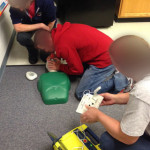Know You have the Best First Aid Trainer!
First Aid Training is a type of training you hope never to use, however depending on your environment you may use first aid training more than any other.
Here, we are providing information regarding how important first aid skills are for EVERYONE, and examples of how and why people with training skills from specific occupations make the very best first aid trainers.
For our purposes and the purposes of this article please note, “First Aid Training” is a combination of First Aid, CPR and AED Training.
Having the knowledge and skills to render care prior to emergency services arriving on scene increases the chances of a positive long term outcome for the victim. In our combined experience, well over 30 years, as emergency service providers, we’ve noticed that about 90% of victims who were provided appropriate first aid had a better long term outcome than those who were not provided first aid within the first 5 minutes. Arguably, this 5 minute timing is why the Occupational Health and Safety Organization (OSHA) enforces a standard that emergency care providers for the workplace cannot be more than 4 minutes away, as pointed out in a previous article. (click here for related article) If emergency services are more than 4 minutes away, OSHA requires that first aid providers be present in the workplace. First Aid knowledge is great for any situation, not just the workplace, however the OSHA standard drives the point for providing immediate care. Non-professional rescuers who initiate care before medics arrive make a remarkable difference.
The best first aid trainers are professional firefighters, paramedics, nurses and EMT’s who have a passion for the subject of First Aid. These people know first-hand that a victim has a better chance of survival when someone nearby has the knowledge and skills to render care prior to emergency services arriving on scene. Professional firefighters, paramedics, nurses and EMT’s provide care on a daily basis. They take those real world examples and knowledge with them when they train. As you can imagine, real examples and true stories keep trainees alert and interested. Providing examples and materials to actually set a broken bone, treat significant cuts, burns, punctures, dismemberment and cardiac arrest are amazing knowledge sharing and skill building tools. It never fails to make us feel great when our students say that they truly enjoy our added involvement in the training because we ask them pointed questions and we provide examples that relate directly to their specific environment. Providing excellent examples specific to a person’s environment or scenario provides students with food for thought directly related to first aid care in their environment.
Make sure instructors go beyond the books and relate their years of experience into training scenarios that will echo in the trainees’ minds and prepare the trainees for actual events.












